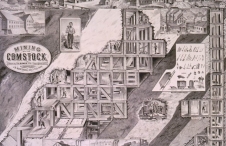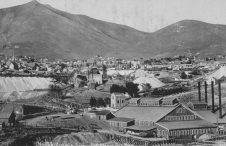Adolph Sutro
Adolph Sutro was a remarkable character whose tunnel remains a legend in the history of mining. Born to Prussian Jewish parents, he immigrated to North America at age twenty in 1850. Sutro tinkered with mechanics while young, but throughout his life he applied himself to a wide range of occupations and diversions. Once in the United States, he set off for San Francisco and became a store owner. By 1856, he was married to Leah Harris, who soon gave birth to a daughter.
In March 1860, Sutro traveled to Virginia City. He proposed a tunnel of modest length to intercept the lowest shafts of the Comstock Mines. As miners dug deeper, Sutro's initial vision soon proved obsolete because the tunnels he first imagined would not drain the ever-deeper works.
Sutro opened an ore mill in Dayton, but he never abandoned the idea of a drainage tunnel. In 1865, he incorporated the Sutro Tunnel Company with a legislative charter and a mandate for a tunnel over three miles in length. Initially, Sutro won support for his plan to drain the mines because it would cut costs. It soon became apparent, however, that Sutro intended to transport ore to his mills and to provide homes for miners who would commute up and down his tunnel from his town called Sutro. By charging mines for drainage, milling, and transportation of miners and ore, Sutro would create a monopoly, shattering the Bank of California's control of the Comstock. William Sharon, local Bank representative, joined forces with powerful allies to stop Sutro.
Sutro exploited the 1869 Yellow Jacket Fire, Nevada's worse mining accident, by maintaining that his tunnel would have provided an emergency evacuation route during the crisis. Although the tunnel probably would not have saved lives, Sutro won support from the Miner's Union, which blamed management and saw the incident as a way to strengthen the position of labor. Sutro acquired financial backing for his tunnel, and political opposition melted away.
Of course, by 1869 circumstances had changed. Mines were descending below the 1,640 foot intersection. In addition, the Virginia and Truckee Railroad provided cheap transportation of ore to company mills in Brunswick Canyon. The Sutro Tunnel no longer threatened the profits of mine owners.
Nevertheless, Sutro began excavating his tunnel, hoping ore bodies would help finance the project, but his excavation passed through mostly barren rock. In 1878, excitement grew on the Comstock as the tunnel neared completion. On September 1, 1878, tunnel workers broke into the Savage Mine within eighteen inches of the planned target. Stocks rose. Sutro, realizing his venture would not be profitable, sold his interests and retired to San Francisco.
With Comstock wealth, Sutro obtained extensive Bay City real estate. He purchased and developed the Cliff House and founded the Sutro Baths and the Sutro Library. Eventually, he built a spectacular mansion at Sutro Heights overlooking his property. Sutro was mayor of San Francisco from 1895 to 1897. After living a full, diverse life, he died in 1898 at the age of sixty-eight.
Article Locations
Related Articles
Further Reading
None at this time.



